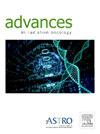基于深度学习的伽玛刀放射治疗中单个脑肿瘤均匀剂量分布的非均匀性校正
IF 2.7
Q3 ONCOLOGY
引用次数: 0
摘要
目的校正非均质性在放射治疗计划中至关重要,以确保准确的剂量传递。脑癌立体定向治疗,如伽玛刀放射手术(GKRS),通常依赖于均匀的水基计算,尽管骨结构附近可能存在异质性影响。本研究旨在开发一种不需要额外的计算机断层扫描(CT)就能产生包含异质性效应的合成剂量计划的方法。方法与材料对100例回顾性收集的GKRS患者和22例前瞻性收集的GKRS患者进行磁共振成像和CT图像、基于tmr10和基于卷积的剂量分布分析。训练条件生成对抗网络将TMR10转化为合成卷积(sConv)剂量。结果生成的二次Conv剂量与实际Conv剂量具有定性和定量上的相似性,与TMR10剂量(γ合格率;sConv剂量,92.43%;TMR10剂量,74.18%。处方等剂量骰子;sConv剂量,91.7%;TMR10剂量,89.7%)。颅骨引起的散射和衰减效应准确地反映在第二次卷积剂量中,表明新的剂量预测模型可以替代耗时的卷积剂量计算。结论深度学习方法为GKRS的非均匀校正剂量计划提供了可行的解决方案,避免了额外的CT扫描和冗长的计算时间。该方法在保持非均匀介质中的剂量分布特征而只需要均匀剂量计划方面的有效性突出了其在常规治疗计划工作流程中包括该过程的实用性。在不同的患者群体中进一步完善和验证可以增强其在临床环境中的适用性和影响。本文章由计算机程序翻译,如有差异,请以英文原文为准。
Deep Learning-Based Heterogeneity Correction of the Homogeneous Dose Distribution for Single Brain Tumors in Gamma Knife Radiosurgery
Purpose
Heterogeneity correction is vital in radiation therapy treatment planning to ensure accurate dose delivery. Brain cancer stereotactic treatments, like Gamma Knife radiosurgery (GKRS), often rely on homogeneous water-based calculations despite the potential heterogeneity impact near bony structures. This study aims to develop a method for generating synthetic dose plans incorporating heterogeneity effects without additional computed tomography (CT) scans.
Methods and Materials
Magnetic resonance imaging and CT images, TMR10-based, and convolution-based dose distributions were used from 100 retrospectively collected and 22 prospectively collected GKRS patients. A conditional Generative Adversarial Network was trained to translate TMR10 into synthetic convolution (sConv) doses.
Results
The generated sConv dose demonstrated qualitative and quantitative similarity to the actual convolution (Conv) dose, showcasing better agreement of dose distributions and improved isodose volume similarity with the Conv dose in comparison to the TMR10 dose (γ pass rate; sConv dose, 92.43%; TMR10 dose, 74.18%. Prescription isodose dice; sConv dose, 91.7%; TMR10 dose, 89.7%). Skull-induced scatter and attenuation effects were accurately reflected in the sConv dose, indicating the usefulness of the new dose prediction model as an alternative to the time-consuming convolution dose calculations.
Conclusions
Our deep learning approach offers a feasible solution for heterogeneity-corrected dose planning in GKRS, circumventing additional CT scans and lengthy calculation times. This method's effectiveness in preserving dose distribution characteristics in a heterogeneous medium while only requiring a homogeneous dose plan highlights its utility for including the process in the routine treatment planning workflows. Further refinement and validation with diverse patient cohorts can enhance its applicability and impact in clinical settings.
求助全文
通过发布文献求助,成功后即可免费获取论文全文。
去求助
来源期刊

Advances in Radiation Oncology
Medicine-Radiology, Nuclear Medicine and Imaging
CiteScore
4.60
自引率
4.30%
发文量
208
审稿时长
98 days
期刊介绍:
The purpose of Advances is to provide information for clinicians who use radiation therapy by publishing: Clinical trial reports and reanalyses. Basic science original reports. Manuscripts examining health services research, comparative and cost effectiveness research, and systematic reviews. Case reports documenting unusual problems and solutions. High quality multi and single institutional series, as well as other novel retrospective hypothesis generating series. Timely critical reviews on important topics in radiation oncology, such as side effects. Articles reporting the natural history of disease and patterns of failure, particularly as they relate to treatment volume delineation. Articles on safety and quality in radiation therapy. Essays on clinical experience. Articles on practice transformation in radiation oncology, in particular: Aspects of health policy that may impact the future practice of radiation oncology. How information technology, such as data analytics and systems innovations, will change radiation oncology practice. Articles on imaging as they relate to radiation therapy treatment.
 求助内容:
求助内容: 应助结果提醒方式:
应助结果提醒方式:


